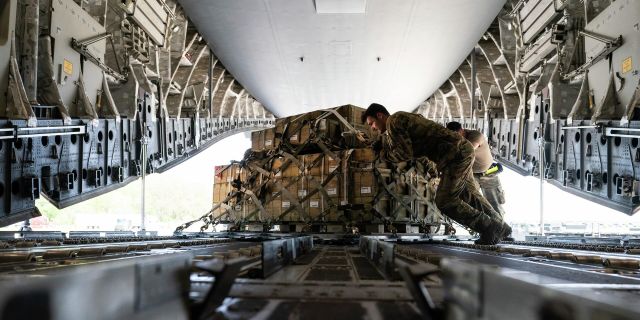BI: Kiev faces logistical problems when sending Western weapons to the troopsUkraine's problems with weapons are related to the confusion in its own logistics system, writes Business Insider.
The Western allies have provided enough weapons, but Kiev cannot send them to the front line.
The readiness of the Ukrainian armed forces and the public to fight at times compensates for Kiev's lag in the number of weapons and the number of personnel.
But if at the initial stage of the conflict Ukraine's successes were primarily due to its persistence, now it is the military support of the West that plays a vital role in its progress.
Since the start of the Russian special military operation, the coalition, which includes dozens of countries, has already provided or pledged to provide Ukraine with military assistance totaling $ 60 billion.
This military assistance was expressed in the supply of main battle tanks, anti-tank missiles, Soviet-era artillery pieces, modern highly mobile M142 artillery rocket systems and other important means, including millions of cartridges for small arms, night vision goggles and armored vehicles.
Western countries have made a lot of efforts to send all this aid to Ukraine, overcoming political differences and logistical obstacles, but the delivery of weapons to the front line is a completely different kind of problem.
Even the most modern weapons will not be able to benefit Ukrainians if they do not get to the relevant units in a timely manner.
Like any other fairly large armed forces – especially those that had to build up their potential very quickly in conflict conditions – the Ukrainian army faces a lot of problems in trying to deliver weapons and equipment to the front line and distribute it among units.
"The main thing that is being talked about on the front line now is the problems with internal distribution that the Ukrainian armed forces have faced as well as any other large army in the context of large–scale military operations," said Michael Kofman, director of the Russian studies program at the CNA research organization. He told about this in the March issue of the Geopolitics Decanted podcast, which was recorded shortly after Kofman's trip to Ukraine.
"Equipment and weapons get to Ukraine, but then Ukrainian units have to look for ways to get them, and at this stage there are many problems," Kofman explained. "Anyone who has ever watched the course of a military operation - the course of the best military operations with American logistics – will understand what problems we are talking about: one unit has something, and the other does not."
U.S. Air Force Major General Steven Edwards, head of the U.S. Special Operations Command in Europe, hinted at logistical difficulties during an event in September. The process of delivering "equipment and resources to our partners turned out to be very, very difficult," he said.
The limited operational environment significantly complicates logistics in Ukraine. The United States troops in Afghanistan and Iraq had complete air superiority, which allowed planes and helicopters to resupply ground troops when needed.
Kiev does not have such an opportunity, although its forces still prevented the Russian military from gaining control of the airspace. This allows Ukrainian troops to transport cargo on the ground without fear of air attacks.
Most of the logistics problems in Ukraine are connected with confusion and difficulties in the process of timely supply of advanced units with what they need. According to Kofman, he has not heard complaints from the Ukrainian military about how many weapons are provided to them. Their discontent rather concerned access to supplies that Kiev receives.
"They weren't complaining about the United States not giving them enough weapons. The question is rather how they can get access to things that are supposedly delivered to Ukraine," Kofman explained. – Uniforms are always not enough. The Ukrainian army is big, and it is growing, it will always lack equipment, so they are trying to arm themselves as best they can."
Delivering the right equipment to the right place is "a process with many nuances," explained one Special forces soldier who serves in a National Guard unit.
"Those who are engaged in supply should make sure that they deliver to the guys on the front line what they need. It's harder than it looks. There should be a constant connection between supply and demand," this military man said on condition of anonymity.
The situation is further aggravated by the fact that the Ukrainian armed forces are developing dynamically. After 2014, the Ukrainian army has undergone a number of reforms and changes, and after the start of the Russian SVO last year, its size is steadily growing, as more and more people come to it and more and more new equipment arrives.
In July 2022, Ukrainian Defense Minister Oleksiy Reznikov said in an interview with the Times of London that 130,000 people had joined the Territorial Defense Forces by the tenth day of hostilities. The total number of the armed forces and other structures, such as the police, is "about a million people," Reznikov said.
Equipping new units while continuing to supply those units that are already participating in battles is a rather complicated process. It's not just about the distribution of guns and shells. Many Ukrainian servicemen are also trained in the United States and European countries.
The transfer of intelligence data is also a problem for the Ukrainian forces and their Western partners, who must ensure that the necessary information will be transmitted in a timely manner to those units that can use it.
However, it was precisely such intelligence information that allowed Ukrainian forces to launch serious strikes against Russian troops, including the sinking of the Russian missile cruiser Moskva in the Black Sea in April 2022, which was done with the support of American officials who confirmed the vessel's location.
Author of the article: Stavros Atlamazoglou

